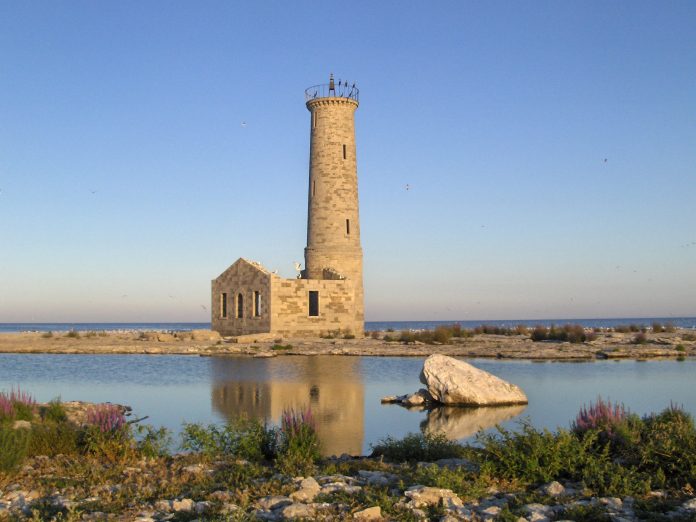
By Susanna McLeod
Special to Ontario Construction Report
Deeper waters with fewer locks, the rebuild of Welland Canal in the early 1840s used hardy limestone instead of wood. Canal improvements simplified travel and transportation in Upper Canada. The locks accommodated cargo ships, steamboats, and smaller boats. At Lake Erie ports and the canal entrance, concealed hazards lurked, waiting to rip into vessel hulls. A lighthouse would prevent disasters and save lives.
Awarded the contract in 1846 to build a lighthouse on Mohawk Island, the Scottish-born stone mason and contractor John L. Brown already had access to the necessary supplies. The 35-year-old had established the Queenstown Quarry only a few years earlier.
The quarry’s high-quality crinoidal dolomite limestone with low porosity and absorption was the prime material for Welland Canal reconstruction and lighthouses. “The government demanded that stone from the Queenston Quarry be used to the exclusion of all others,” said Wayne Sapulski in “John L. Brown” in Great Lakes Cruiser. For Brown, the Mohawk Island project was the catalyst leading to further lighthouse contracts.
Work on the island began in 1847 with a crew erecting temporary worker quarters. Transporting quarried stone from the mainland was complicated. First hauled “overland to Port Robinson then by ship through the Welland Canal, transferred to Port Maitland via the Feeder Canada, then out to the island,” said Dunnville Online’s history of Mohawk Island Lighthouse.
Designed in Neoclassical style, the lighthouse and attached keeper’s quarters were built to last. The 18-metre tapered tower was constructed with hammer-dressed stones that changed into smooth-faced stones further up. Brown’s crew spent time and care to include architectural features such as “the stones around the doors and windows are raised relative to the surface of the walls,” according to Sapulski. The builders also included dentils beneath the lantern deck.
Brown selected quality stones and the finest mortar blend to fulfill his contract. “Even today,” stated Sapulski, “they have no cracks or fissures to let water in which would have led to cracking during cold weather.”
Manually winding the apparatus several times a day, the first keeper, farmer Jim Burgess, climbed six flights of stairs to reach the lighting equipment. Ten lamps, “each set in a parabolic reflector, and was revolved by a clockwork mechanism that was powered by a weight suspended in the tower,” wrote Lighthouse Friends. Once, when the revolving device failed, the keeper and his son used a blanket to replicate the flash pattern.
A hallway led from the tower to the small one-storey house. The keeper enjoyed a sitting room, a kitchen, and one bedroom. For his crucial work, Burgess earned £65 per season.
Experience in construction and commerce made Brown the optimal candidate for another government contract. Six towers for Georgian Bay and Lake Huron were requested to improve safety for ever-increasing shipping on the waterway. With expanded and profitable business holdings, Brown’s wealth permitted him to take on immense ventures that others would not dare to accept. In mid-1850s, the Imperial Towers project was launched, with lighthouses scheduled for Cove, Nottawasaga, Christian, Griffith, Chantry, and Point Clark.
Unlike the smooth operations of his first project, transportation of workers and building materials turned into an alarming undertaking. Frequent storms caused delays and dangers. “Four supply boats went down with their loads before even reaching the sites, victims of the very navigation hazards the lighthouses were being built to warn of,” said Sapulski in Lighthouse Digest, December 1996. “One of the four was sunk by an ice flow and countless times materials were swept overboard.”
Rather than building temporary quarters for Imperial Towers workers, the keepers’ houses were constructed first. Ranging in height from about 16.8 m at Christian Island to 24.4 m for the five others, the towers were built to withstand weather and time. Basement courses ran 2.1 m thick. “At ground levels, the walls were fully six feet thick (1.28 m), tapering until they reached a thickness of two (.60 m) at the top where the walls flared,” noted Sapulski, providing “support for the outside gallery around the light.”
Each lantern room was very heavy; granite was added just below for sufficient support. Lenses were state-of-the-art, according to Sapulski, shipped from France with a crew of technicians for installation. The lanterns produced condensation, so much that eavestroughs with ornamental spouts were installed at each pane of glass.
Brown’s six extraordinary Imperial Tower lighthouses were lit for service between October 1858 and May 1859. The contractor won medals at World’s Fairs in Paris, France in 1855 and London, England in 1862 for the quality of his plaster and cement materials. John Brown died in 1876.
Now in ruins and without a lantern room, Mohawk Island Lighthouse is part of the Mohawk Island National Wildlife Area. Designated one of Canada’s Historic Places in 1993, it remains a beacon of architectural and historical significance.
© 2022 Susanna McLeod. McLeod is a Kingston-based freelance writer who specializes in Canadian History.
